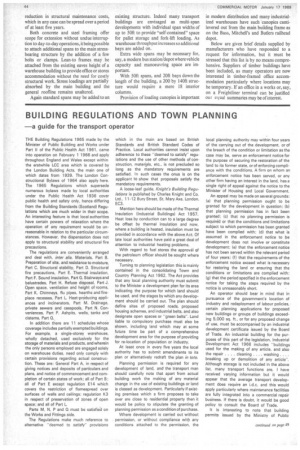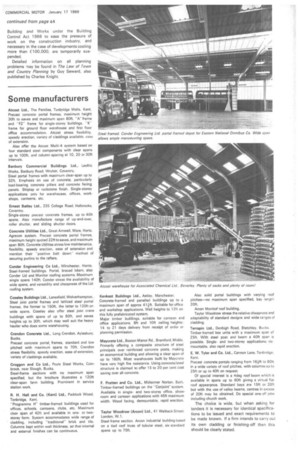BUILDING REGULATIONS AND TOWN PLANNING
Page 46

Page 51

If you've noticed an error in this article please click here to report it so we can fix it.
—a guide for the transport operator THE Building Regulations 1965 made by the Minister of Public Building and Works under Part II of the Public Health Act 1961, came into operation on February 1 1966 and apply throughout England and Wales except within the erstwhile LCC area which is covered by the Landon Building Acts, the main one of which dates from 1939, The London Constructional Bylaws of 1964 also apply here. The 1965 Regulations which supersede numerous bylaws made by local authorities under the Public Health Act 1936 cover public health and safety only, hence differing from the Building Standards (Scotland) Regulations which are much wider in their scope. An interesting feature is that local authorities have certain powers of relaxation where the operation of any requirement would be Unreasonable in relation to the particular circumstances. However, the dispensation does not apply to structural stability and structural fire precautions.
The regulations are conveniently arranged and deal with, inter alia, Materials. Part B. Preparation of site, and resistance to moisture, Part C. Structural stability, Part D. Structural fire precautions. Part E. Thermal insulation, Part F. Sound insulation, Part G. Stairways and balustrades. Part H. Refuse disposal, Part J. Open space, ventilation and height of rooms, Part K. Chimneys, flu pipes, hearths and fireplace recesses, Part L. Heat-praducing appliances and incinerators, Part M. Drainage, private sewers and cesspools, Part N. Conveniences, Part P. Ashpits, wells, tanks and cisterns. Part Q..
In addition there are 11 schedules whose coverage includes partially exempted buildings. For example, a single-storey warehouse, wholly detached, used exclusively for the storage of materials and products, and wherein the only persons employed are engaged solely on warehouse duties, need only comply with certain provisions regarding actual construction. These are: General Part A, in respect of giving notices and deposits of particulars and plans, and notice of commencement and completion of certain states of work: all of Part B: all of Part E except regulation E14 which covers the restriction of flamespread over surfaces of walls and ceilings; regulation K3 in respect of preservation of zones of open space; and all of Part L.
Parts M. N. P and Q must be satisfied on the Works and Fittings side.
The Regulations make much reference to alternative "deemed to satisfy" provisions which in the main are based on British Standards and British Standard Codes of Practice. Local authorities cannot insist upon adherence to these "deemed to satisfy" regulations and the use of other methods of construction, materials, etc., is not precluded so long as the mandatory requirements are satisfied. In such cases the onus is on the applicant to show that proposals satisfy the mandatory requirements.
A loose-leaf guide, Knight's Building Regulations is published by Charles Knight and Co. Ltd., 11-12 Bury Street, St. Mary Axe, London, EC3.
Mention here should be made of the Thermal Insulation (Industrial Buildings) Act 1957. Heat loss by conduction can to a large degree be offset by thermal insulation and now, where a building is heated, insulation must be provided in accordance with the above Act. Of late local authorities have paid a great deal of attention to industrial heating problems.
With regard to fuel stores the approval qf the petroleum officer should be sought where necessary.
Turning to planning legislation this is mainly contained in the consolidating Town and Country Planning Act 1962. The Act provides that any local planning authority must submit to the Minister a development plan for its area indicating the purpose for which land should be used, and the stages by which any development should be carried out. The plan should define sites of proposed roads, proposed housing schemes, and industrial belts, and also designate open spaces or "green belts-. Land liable to compulsory purchase must also be shown, including land which may at some future time be part of a comprehensive development area for the purpose of providing for re-location of population or industry.
At least once in every five years the local authority has to submit amendments to its plan or alternatively redraft the plan in luta
Planning permission is required for any development of land, and the transport man should carefully note that apart from actual building work the making of any material change in the use of existing buildings or land is classed as development. Particularly if existing premises which a firm proposes to take over are close to residential property then it would be policy to stipulate the granting of planning permission as a condition of purchase.
Where development is carried out without permission, or without compliance with any conditions attached to the permission, the local planning authority may within four years of the carrying out of the development, or of the breach of the condition or limitation as the case may be, serve an enforcement notice for the purpose of securing the restoration of the land to its former state, or of enforcing compliance with the conditions. A firm on whom an enforcement notice has been served, or any other firm having an interest in the land, has a single right of appeal against the notice to the Minister of Housing and Local Government.
An appeal may be made on several grounds: lal that planning permission ought to be granted for the development in question: (b) that planning permission has in fact been granted; lc) that no planning permission is requirdd or that the conditions and limitations subject to which permission has been granted have been complied with; (d) that what is assumed in the enforcement notice to be development does not involve or constitute development: (e) that the enforcement notice has not been served within the relevant period of four years; (f that the requirements of the enforcement notice exceed what is necessary for restoring the land or ensuring that the conditions or limitations are complied with: (g) that the period specified in the enforcement notice for taking the steps required by the notice is unreasonably short.
An operator should bear in mind that in pursuance of the government's location of industry and redeployment of labour policies, certain planning applications for proposed new buildings or groups of buildings exceeding 5.000 sq. ft., or for any proposed change of use, must be accompanied by an industrial development certificate issued by the Board of Trade. An industrial building for the purposes of this part of the legislation, Industrial Development Act 1966 includes "buildings used for the making of any article. and also the repair . . . . cleaning . . . . washing .
breaking up or demolition of any article". Although storage is not included in the above list, many transport functions are. I have received varying information but it would appear that the average transport development does require an i.d.c. and this would apply particularly where maintenance facilities are fully integrated into a commercial repair business. If there is doubt, it would be good policy to consult the Board of Trade.
It is interesting to note that building permits issued by the Ministry of Public Building and Works under the Building Control Act 1966 to ease the pressure of work on the construction industry, and necessary in the case of developments costing more than £100,000, are temporarily suspended.
Detailed information on all planning problems may be found in The Law of Town and Country Planning by Guy Seward, also published by Charles Knight.








































































































